This article has multiple issues. Please help improve it or discuss these issues on the talk page . (Learn how and when to remove these messages)
|

The Weser Tower is a multistorey building in Bremen.
This article has multiple issues. Please help improve it or discuss these issues on the talk page . (Learn how and when to remove these messages)
|

The Weser Tower is a multistorey building in Bremen.
It was designed by the American architect of German origin Helmut Jahn. [1] The laying of the foundation was on 23 October 2007. The Tower of 82 metres height is the tallest office building of Bremen and was completed in 2010.
The 22 floors of the building have a surface of 18,000 square metres and thus place for 800 jobs. Among this large-scale project rank also a new hotel, a Varieté theatre, restaurants and further office buildings. Principal tenant are subsidiary companies of the power supplier EWE AG, which takes over all together 13 floors of the building.

Aktien-Gesellschaft "Weser" was one of the major German shipbuilding companies, located at the Weser River in Bremen. Founded in 1872 it was finally closed in 1983. All together, A.G. „Weser" built about 1,400 ships of different types, including many warships. A.G. „Weser" was the leading company in the Deutsche Schiff- und Maschinenbau AG, a cooperation of eight German shipbuilding companies between 1926 and 1945.

Vegesack is a northern district of Bremen, the capital of the German state Free Hanseatic City of Bremen.

Weserstadion is a football stadium in Bremen, Germany. The Weserstadion is scenically situated on the north bank of the Weser River and is surrounded by lush green parks. The city center is only about a kilometre away. It is the home stadium of German Bundesliga club Werder Bremen.

Hermann-Böse-Gymnasium (HBG) is a co-educational secondary school in Bremen, Germany.

Schnoor is a neighbourhood in the medieval centre of the German city of Bremen, and the only part of it that has preserved a medieval character. The neighbourhood owes its name to old handicrafts associated with shipping. The alleys between the houses were often associated with occupations or objects: There was an area in which ropes and cables were produced and a neighboring area, where wire cables and anchor chains were manufactured.

The Shipper's House in Bremen, Germany is a building in the oldest district of the Free Hanseatic city of Bremen. The house was registered as an historical monument in 1973 and is in Schnoor. During the last 25 years of the 20th century the house was a private museum. It was an attraction for many visitors including the former German Foreign Minister Hans-Dietrich Genscher.

The region between the Elbe and Weser rivers forms the Elbe–Weser triangle, also rendered Elbe-Weser Triangle, in northern Germany. It is also colloquially referred to as the Nasses Dreieck or "wet triangle".
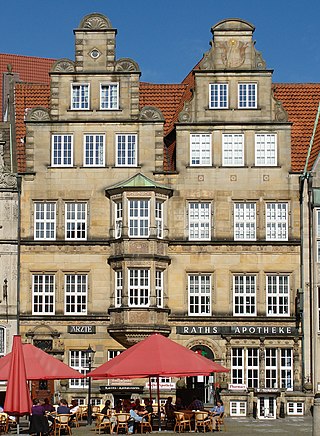
The Raths-Apotheke is a listed building on the Market Square (Marktplatz) in Bremen, Germany. After suffering war damage, the building was restored with two gables in the Neobaroque style in 1958, re-establishing the square's sequence of gabled buildings dating from the 1820s.
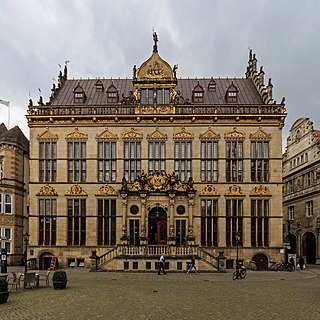
The Schütting, situated on the Marktplatz in Bremen, initially served the city's merchants and tradesmen as a guild house. In 1849, it became Bremen's chamber of commerce. Since 1973, it has been under monument protection. It lies on the south site of the Bremen marketplaces directly across from the town hall.

The Stadtwaage at No. 13 Langenstraße in Bremen (Germany) is the building in which the municipal weighing scales used to be housed. The facility was created in order to levy taxes and excise duties while protecting merchants and customers against fraud and dishonesty.

The New Town Hall has stood on the Domshof in the centre of Bremen, Germany since 1913. Located behind the Unser-Lieben-Frauen-Kirchhof cemetery, it is adjacent to the older section of the Town Hall with which it forms a harmonious ensemble. Among its sumptuous rooms decorated with local artefacts, the New Town Hall houses the Senate Chamber used by the Senate for its regular meetings and the Great Hall, a venue for official receptions. In 2004, Bremen Town Hall was listed as a UNESCO World Heritage Site, together with the Roland of Bremen, because of its outstanding architecture and testimony to the development of civic autonomy during the Holy Roman Empire.
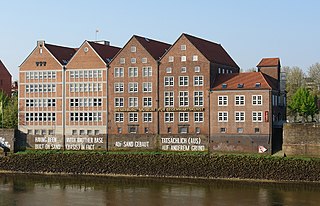
The Weserburg is a modern art museum in Bremen, Germany. Opened in 1991, it is located on the Teerhof peninsula next to the River Weser in an old factory building which was almost completely destroyed in the Second World War. Originally known as "New Museum Weserburg Bremen", it was Europe's first "collectors' museum", in that it conserves no permanent collection but mounts changing exhibition of private collections. It is one of the largest modern art museum spaces in Germany.
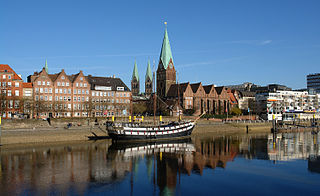
The Schlachte is a promenade along the east bank of the River Weser in the old town of Bremen in the north of Germany. Once one of the city's harbours, it is now popular for its restaurants, beer gardens and river boats.

The Landherrnamt is a building in the Schnoor district of Bremen, Germany, which was designed by Alexander Schröder in the Neo-Romanesque style and completed in 1856.

The Teerhof is a peninsula between the River Weser and the Kleine Weser, opposite the city centre of Bremen, Germany. It was first mentioned in 1624 as "Theerhof" when it was the northernmost part of an island. Today it consists mainly of residential buildings and the Weserburg modern art museum.

The Langenstraße is a historical street in the old town of Bremen in the north of Germany. First mentioned in 1234, it is one of Bremen's oldest streets and one of the most important for the city's merchants. It no doubt originated at the time when the first settlements grew up on the north bank of the Balge. It runs west from the Marktplatz parallel to the River Weser over Bürgermeister-Smidt-Straße to Geeren. Many of the street's historic buildings were seriously damaged during aerial bombings in the Second World War but were carefully reconstructed in the postwar period.

The Suding & Soeken building is a gabled house at No. 28 Langenstraße in Bremen, Germany. Referred to as a Kaufmannshaus or Kontorhaus, it is one of the city's few historic merchant houses to survive the war undamaged. It is noted for its projecting Renaissance bay window and its two-tiered Baroque stairway ascending from the hallway.
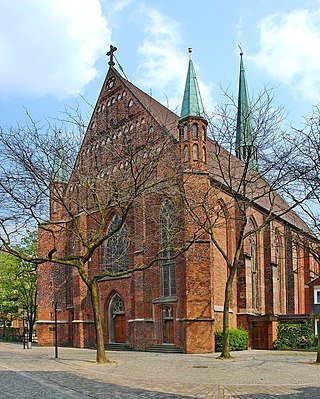
St. John's Church is a Roman Catholic provost church in Bremen. It was built in the fourteenth century as a Franciscan abbey church and has been a listed monument since 1973.
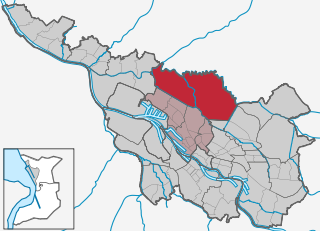
Blockland is a landscape and nowadays a borough of Bremen, Germany. It is part of the Western municipal district and covers an area of 30.3 km2.
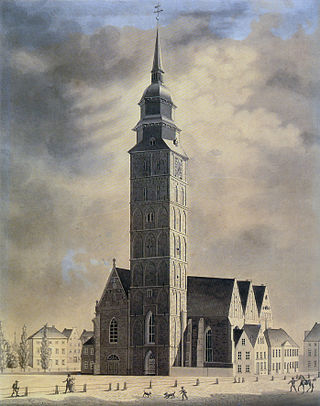
St. Ansgarii Church was a medieval Brick Gothic church in Bremen. The 97-meter-high tower was the tallest landmark of the city for centuries. The church was the starting point of the Reformation in Bremen. The building was severely damaged during World War II and the ruin was demolished in the 1950s. A new church building under the same name was constructed outside of the old city.